We have all, at some point, stared at the stars and dreamed lazily of other worlds, but, fortunately, for many of us, dreaming alone was not enough. These people set about building a toolkit stocked with instruments and techniques to find planets outside our solar system — exoplanets. In turn, these tools help us better understand our place in the Universe.
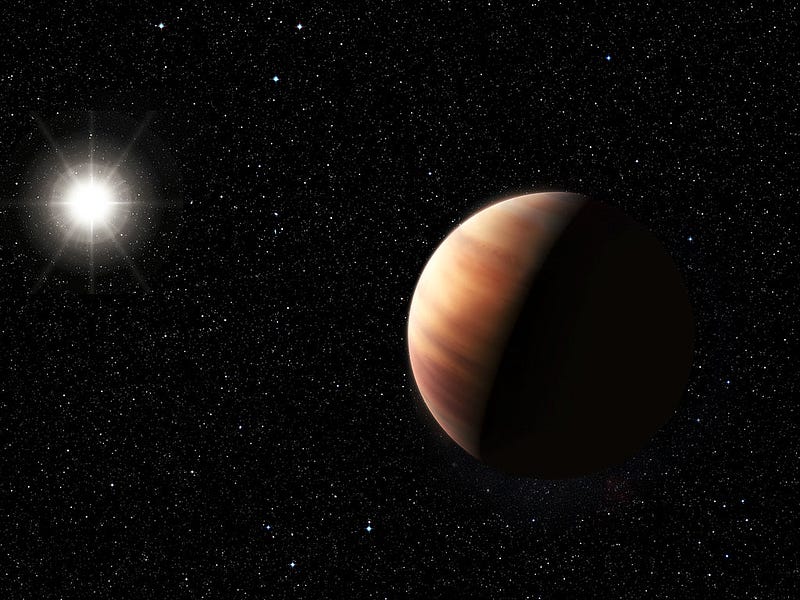
In October the Nobel Committee awarded the 2019 Nobel Prize in Physics to Michel Mayor, Professor at the Observatory of the Faculty of Science of the University of Geneva (UNIGE), Switzerland, and his doctoral student Didier Queloz for their discovery of 51 Pegasi b in 1995 — which marked the first discovery of an exoplanet orbiting a Sun-like star. The award marked the first time that exoplanet research has scooped what is, arguably, the most prestigious prize in science. Quite fitting as even though 51 Pegasi b was not the first exoplanet to be discovered — that honour goes to Astronomers Aleksander Wolszczan and Dale Frail who discovered an exoplanet around a neutron star in 1992 — it was Mayor and Queloz’s breakthrough that really spurred on the science of exoplanet investigation.
As extraordinary as it sounds, before the 1990s, it wasn’t entirely certain that other stars actually possessed planets of their own. Whilst there was technically no reason to suspect that the solar system was unique, the 1980s had proved a frustrating time for exoplanet hunters. By the turn of that decade, many potential candidates had come and gone evading positive confirmation.
Despite early setbacks, since 1995, the catalogue of exoplanets has soared, with over 4,000 examples now in NASA’s catalogue. And with technology only improving, that collection is set to soar. This animation and sonification from SystemSounds is a stunning representation of how the field has exploded since the 1990s. Created by SYSTEM Sounds (Matt Russo, Andrew Santaguida)
We are becoming so confident in the discovery of exoplanets, that we are now turning our attention to much more detailed examinations of previously discovered examples. For example, many researchers are now focusing on the investigation of exoplanet atmospheres, attempting to discover if they contain traces of chemicals such as carbon monoxide and other organic and complex molecules, and, of course, water. Should these elements be observed it constitutes a clue, a tiny hint, that life may not be unique to our planet.
Thus far, searches for exoplanets have been more effective in finding gas giants, planets similar to Jupiter. But new advances such as the James Webb Space Telescope and the Extremely Large Telescope have researchers salivating at the idea of finding and examining smaller, rocky planets. Planets just like Earth. And of course, the discovery of the Trappist-1 system — containing seven Earth-like rocky planets, three in the so-called ‘habitable zone’ capable of harbouring liquid water — has shown that these planets are definitely out there waiting for us to find them.

As such, exoplanet research stands on the cusp of providing an answer to the question we have all pondered at some point whilst staring at the stars, are we alone in the universe?
Of course, the fact that it took so many years of fruitless searching to begin to successfully spot exoplanets illustrates, these blighters are extremely difficult to observe. This means that astronomers have had to develop extremely precise and sensitive methods of exoplanet detection. These techniques are numerous, each with its own strengths and weaknesses.
Wobbly Stars
It goes without saying that before we spotted the first exoplanet, our experience of observing other planets was restricted to our neighbours in the solar system. This was done exclusively through direct imaging, but this technique becomes much more difficult as the distance to an object increases.
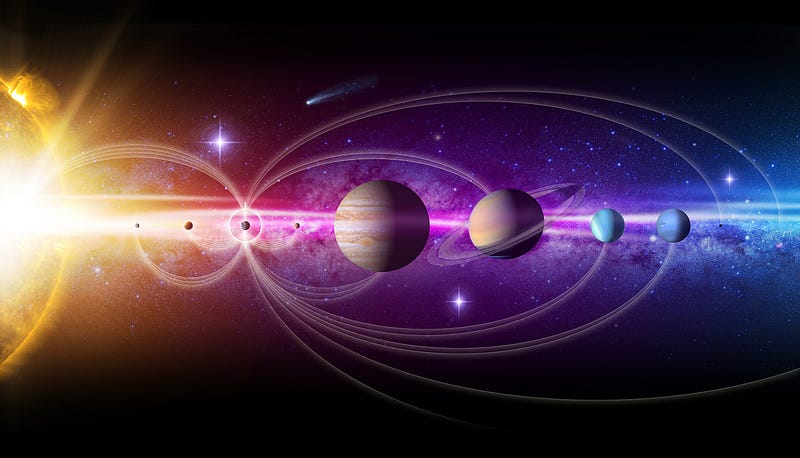
The hindrances imposed on direct imaging increase exponentially when we consider the effect of attempting to spot a dim object next to a much bright one — exactly the scenario faced when attempting to spot a distant planet orbiting its parent star. But, this proximity to an extremely bright object is not always a hindrance to exoplanet detection. In fact, many methods of spotting these planets absolutely depend on it. If a dim object can have an effect of the extremely bright object — then the ability to observe this bright object is a benefit.
This interference arises from the fact that stars with planets orbiting them demonstrate a ‘wobble’ in their motion. This arises from the fact, that despite common belief, planets don’t actually orbit stars. In fact, planets and stars orbit a mutual centre of mass— or barycentre —its location based on the masses of the planets and stars involved. As the usual set-up of a planetary system involves a star that is tremendously more massive than its planets, this mutual point of orbit is usually closer to the star centre of mass — often within the star’s surface.
This huge disparity in mass means that this ‘wobble’ is tiny. As an example, consider our own solar system. As the Sun constitutes more than 99.9% of the total mass of the solar system, the barycentre for our planetary system is located very close to our star’s centre of mass. The most significant gravitational influence on the Sun arises as a result of the solar system’s most mass planet — Jupiter.
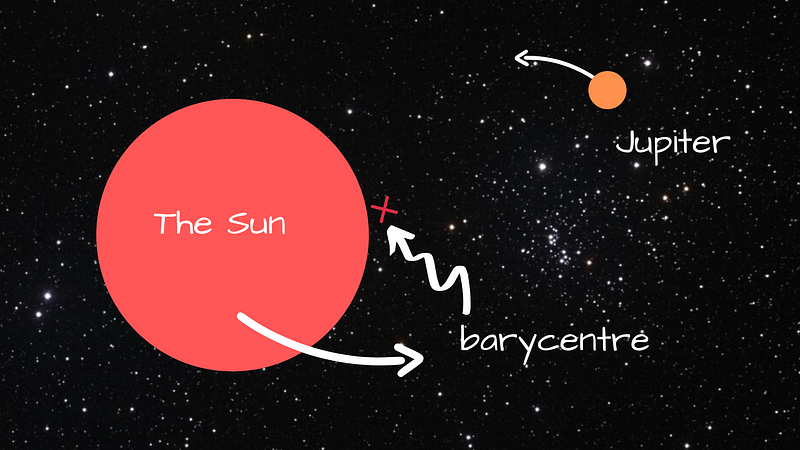
Let’s imagine, for simplicity’s sake, that Jupiter is the only planet orbiting the Sun. An observer viewing this reduced solar system and Jupiter’s 12-year orbit from the nearest planetary system — Alpha Centauri, 4.4 light-years away — would see the Sun as a mere point of light. The shift in its position caused by Jupiter would be just 3.7 milliarcseconds. To put this shift into perspective, consider that one pixel in an image from the Advanced Camera for Surveys aboard the Hubble Space Telescope represents 50 milliarcseconds — one pixel! Thus you can see, this ‘wobble’ caused by Jupiter is a tiny, barely perceptible amount of movement, less than 1/10 of a pixel from the nearest star!
Two further things to consider in this hypothetical situation, Jupiter is the most massive planet in the solar system, the wobble caused by Earth viewed from the same position would be smaller by a factor of at least 300. Also, many of the exoplanets that we are attempting to spot are much further afield than 4.4 light-years. That means that any method using this wobble must be incredibly sensitive and precise. Incredibly, despite this tiny effect, the wobble has spawned several methods of exoplanet detection.
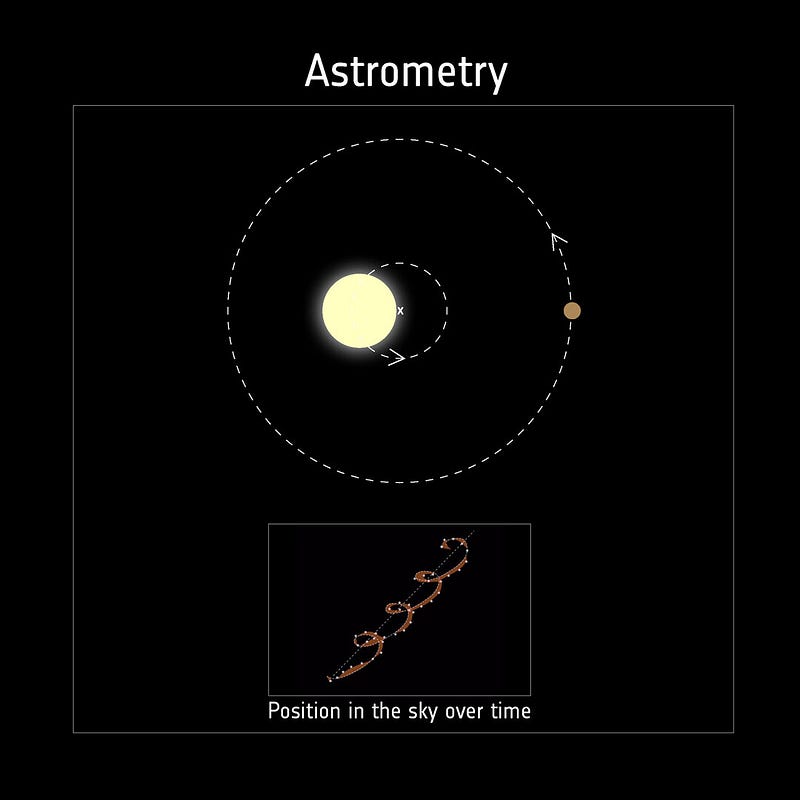
One of these methods is astrometry — very effective for detailing high-mass planets in wide orbits around relatively low-mass stars, and thus not well suited to tracking down Earth-like, rocky planets. For an indirect observation method, astrometry is pretty good at pinning down characteristics like mass, and orbital period, shape and width. Unfortunately, it isn’t great at actually identifying planets.
Thankfully there are other indirect techniques that have helped astronomers help find exoplanets — one of which combines a star’s ‘wobble’ with a phenomenon familiar to drivers and pedestrians everywhere.
Sirens, soundwaves and stars. The Doppler Wobble
I’m sure everyone reading this has been in a situation in which an ambulance with sirens blaring has raced towards them, passed their position and continued on its journey. You’ll have likely noticed that as the vehicle approaches the sound of its siren is higher pitched, switching to a lower pitch as it moves away.
This is because as the soundwaves are emitted by the approaching ambulance they are compressed and shorter wavelength sound waves mean a higher-pitched sound. As the siren recedes, the soundwaves are stretched out — resulting in a lower pitch.
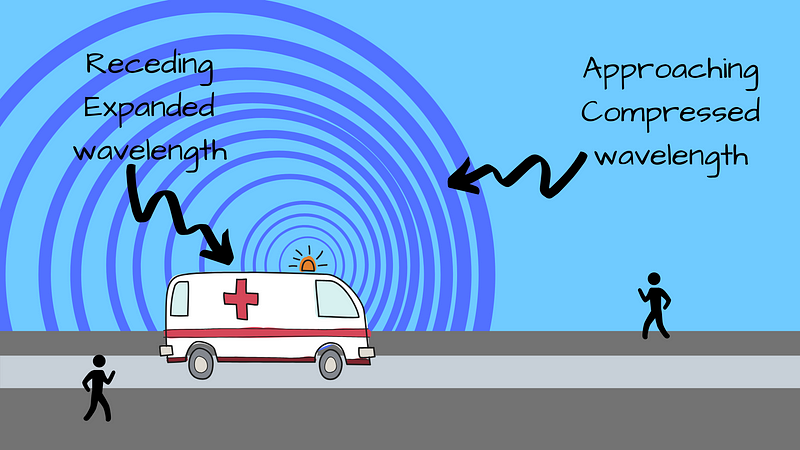
This is the Doppler effect, and the key thing for astronomers is, it applies to any kind of wave emitted by a moving object — even light which propagates as a wave. Just as the wavelengths of soundwaves correspond to different pitches, the wavelengths of light correspond to different colours. Longer wavelengths producing a reddening, shorter wavelengths produce bluer light. This is referred to as redshift and blueshift— a crucial phenomenon in astronomy.
Instead of an ambulance, let’s think about a star moving towards us, as the light waves emitted are compressed — causing the light signature of the star to be shifted towards the blue end of the spectrum. As the star moves away, the light is stretched out again — shifting the light signature towards the red end of the electromagnetic spectrum.
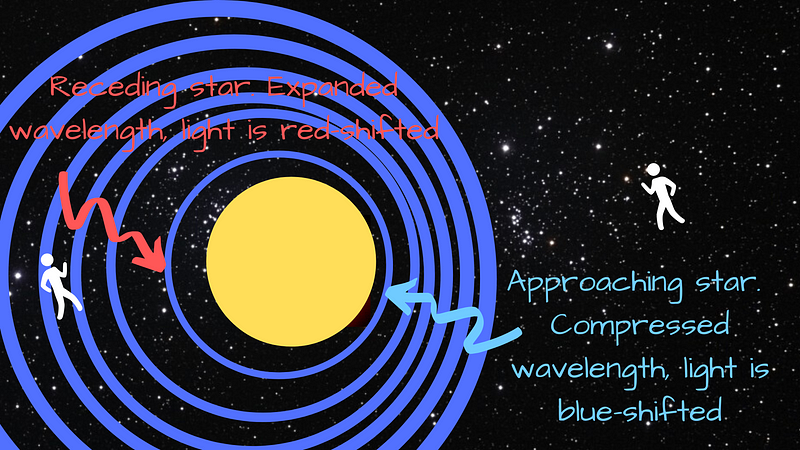
If this is the case, why do the lights atop the ambulance as it recedes not appear redder than they were on their approach? This is because the amount of red and blue shift is determined by an object’s speed divided by the speed of light c. As c is so large, an object would have to be moving at tremendous speeds to result in a significant enough change in colour for us to notice.
You might be wondering how exactly scientists can tell that a star’s signature has shifted towards either end of the electromagnetic spectrum. This is because stars don’t emit light in a constant ‘smear’ across the spectrum. There are notable dark bars where light is not emitted — referred to as the absorption spectrum. It is by tracing the shift of these bars that researchers can see if a star is wobbling and by how much, thus inferring the presence of exoplanets.
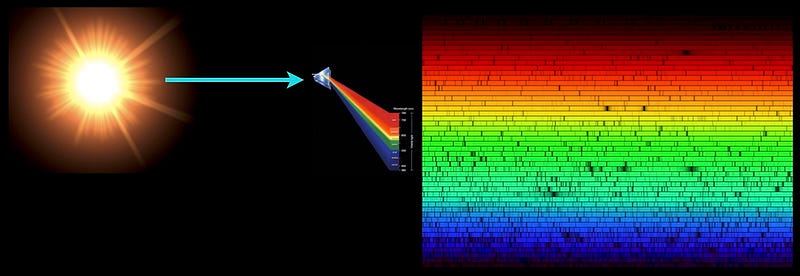
Of course, you may well have noticed a flaw with this technique. It’s only useful in detecting exoplanets that are causing their star to wobble towards and away from Earth. This gives rise to the method’s alternative name — the radial-velocity method. In addition to this blind-spot in glimpsing planets moving perpendicular to Earth, the Doppler-wobble technique can also only tell us what a planet’s minimum mass is.
But, knowledge of the light signature of a star gives rise to another tool in the exoplanet hunter’s arsenal, one which depends on planets crossing — or transiting — their parent star. The photometry technique.
Don’t cross me!
The photometry technique measures the dip in brightness of a star caused as a planet crosses in front of it, thus allowing us to infer the presence of an exoplanet and even collect details about a few of its characteristics. The method clearly requires searching for rare eclipse events where a planet blocks some of its parent star’s light.
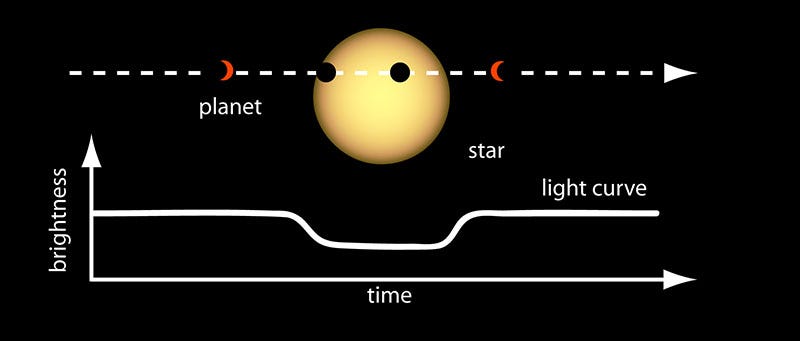
You may be unsurprised to learn that like the other methods detailed above, the photometry technique has to be incredibly sensitive. In this case, that is because the disparity in size between a star and a planet orbiting it is so huge in the star’s favour that the light obscured by this transit is minuscule.
To illustrate this, take a look at this image of Mercury transiting the Sun seen from within the solar system.
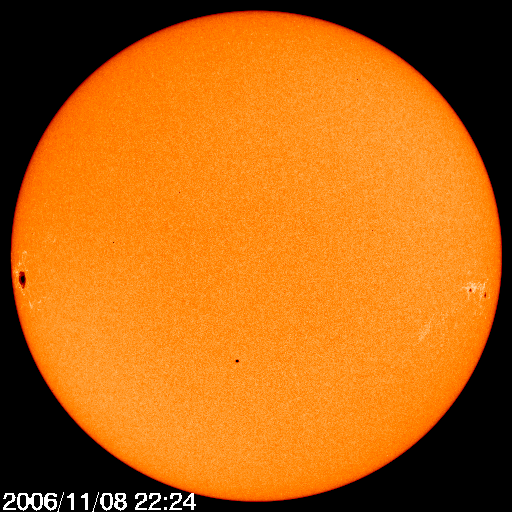
This speck, highlighted below, is Mercury. Now imagining the tiny fraction of light this would have obscured. When you’ve done that, imagine viewing this scene from millions of light-years away!
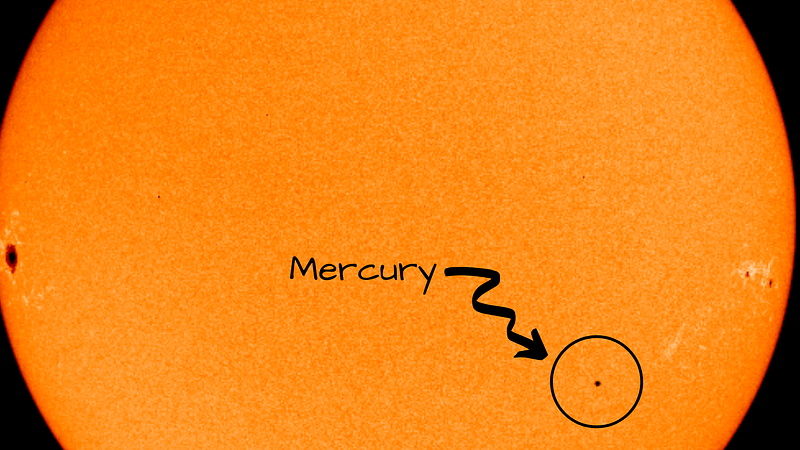
Returning to the example of Jupiter, the largest planet in our solar system, when it transits the Sun it blocks just 1% of the star’s light — making the Sun appear 1% fainter for a period of 12 hours. As small as it is, in comparison to the phenomena exploited by the two methods above this effect is massive.
And again, like its fellow methods of exoplanet detection, the photometric technique has significant limitations that define the situations in which it can be employed. Many planets don’t transit their parent stars and those that do have to be orientated ‘just right’ for the photometry method to work. Also, transits that do occur are incredibly brief, so it takes a lot of good fortune to catch one. That means that the vast majority of exoplanets that we believe exist out there in the depths of space can’t be spotted by this method.
The Earth’s atmosphere and the ‘twinkling effect’ it has on stars is also a major hindrance to the photometry method. This results in its reliance on space-based telescopes. By taking the atmosphere out of the equation, it is possible to not just improve the precision of our measurements but also allows for the continuous monitoring of a star’s brightness without the agony of something as mundane as a rainy-day ruining data.
The future of exoplanet research is extremely bright
With all the limits and drawbacks I’ve listed it may seem like searching for exoplanets is something of a hopeless task, like searching for a needle in a haystack. Except there are 100 billion ‘haystacks’ or stars outside of our analogy in each galaxy. Clearly its a tribute to our advances in science that we have found 4000 or so ‘needles’ thus far.
The astrometry technique, the first tool we examined in the exoplanet hunter’s toolkit isn’t particularly useful, but the second, the doppler technique has been a real boon. It kickstarted exoplanet-hunting as a viable scientific field in the ’90s and provided the majority of discoveries right up into the 2000s. Despite this, its the transit technique — photometry — the last piece of equipment that we turned over, that holds the most promise for the future.
It was a slow starter for sure, reaching maturity much later than the previous two methods mentioned. But, as the use of automated and space-based telescopes has become more prevalent, the ability to keep thousands of stars under constant observation is making the photometry technique the exoplanet-hunting tool that promises to push the boundaries of our understanding of planets elsewhere in the universe.
As our catalogue of exoplanets expands, researchers also now begin to look beyond just spotting these other worlds. The CHEOPS telescope will launch this week (17/12/19) with its mission to spot exoplanets close-by that warrant further investigation. And it is the James Webb Space Telescope, launching in 2021, that will really delve into these selected planets.

Researchers will then use some of the methods I’ve listed above to examine the atmospheres of these planets, a ‘deep-dive’ that would have seemed like little more than a pipe-dream in 1995 when Michel Mayor and Didier Queloz spotted 51 Pegasi b.
Exoplanet research, in many ways, represents one of the ultimate expressions of the drive to perform science. For its pioneers, the men and women that stocked our toolkit, it simply wasn’t enough to lie back staring at the stars, dreaming of other worlds.



